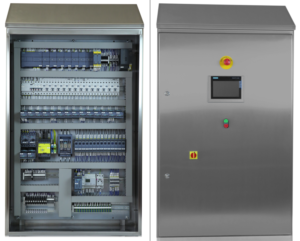Pipelines transporting various liquids in open space must often be protected against freezing by using electrical heating wires. Effectiveness and reliability are vital. ATER Logic from Olsztyn, Poland is modernizing heating pipelines systems, allowing full control and process monitoring through the use of IO-Link.
Background
At a food processing factory in Germany, liquid ingredients are transported between buildings separated by a large distance. The pipelines are protected from freezing through electrical heating wires, wrapped around pipes, and insulated. The existing system had been working autonomously and without failure for a while. However, recent damage to the heating circuit caused the pipeline to freeze. The result was a halt in production at a severe financial cost.
How Heating Wires Operate
Electrical current flows through residual heating wires. Changing the heat is determined through wire resistance, which depends on temperature. When the temperature is dropped, so does the wire resistance. To compensate, the electrical current is increased to generate the necessary heating energy. Therefore to protect against freezing, the only thing that’s required is to pick a suitable type of heating wire, and lay it properly. It is also necessary to monitor both the heating process and any alarm faults in the current flow.
Automation System Requirements
It became obvious at the processing plant that a simple system of pipeline warming with heating wires might be effective, but ideally should be equipped with a control system, diagnostics, and alarms. Plus, the new solution should integrate with the factory’s existing SCADA system for visualization. The final demand from the factory was to reduce cabling to a minimum and the new command system be centrally located in the plant.
ATER Logic’s Solution
 The solution proposed by ATER Logic was based on an integrated Siemens solution, but modified to meet the factory technicians’ demands. It offered more possibilities of enhanced diagnostics, including the ability to determine leaks in the pipeline, complex control of energy use, and maximized efficiency of the heating wires. Moreover, according to the project specifications the new system communicates, generates alarms, and reports through the SCADA system operating in the factory. Cabling reduction, and complex diagnostics were provided by current monitors with IO–Link communication (one, for every heating circuit), and contactors with IO–Link modules. All electrical devices were placed in a new control cabinet, designed and implemented by ATER Logic.
The solution proposed by ATER Logic was based on an integrated Siemens solution, but modified to meet the factory technicians’ demands. It offered more possibilities of enhanced diagnostics, including the ability to determine leaks in the pipeline, complex control of energy use, and maximized efficiency of the heating wires. Moreover, according to the project specifications the new system communicates, generates alarms, and reports through the SCADA system operating in the factory. Cabling reduction, and complex diagnostics were provided by current monitors with IO–Link communication (one, for every heating circuit), and contactors with IO–Link modules. All electrical devices were placed in a new control cabinet, designed and implemented by ATER Logic.
Project Execution
The new cabinet for heating wires control has been equipped with:
- PLC control
- IO-Link communication modules
- Current monitors communicating via IO-Link
- IO-Link-enabled contactors
- HMI visualization
Because of the IO-Link communication, the controller now has the capability to:
- Read the electrical current in the power supply of every contactor -allowing the determination if a residual current device is switched on
- Read diagnostics if the contactor is operating properly
- Turn the contactors on/off via PLC logic
- Read the current value of the heating circuit
Additionally, an energy monitor has been placed in-line with the power supply main. It is now possible to exactly measure the seasonal cost to keep the pipeline warm. This monitor is connected via OPC UA to the factory’s SCADA system.
Looking Ahead
The system prepared by ATER Logic is ready for further expansion and integration with the factory central control system. In the winter a thorough current monitoring of the heating wires was conducted. An analysis of the results will determine the nominal values for specific circuits, assist in setting alarm thresholds, and detect any damages to the pipeline insulation, or leaks.
